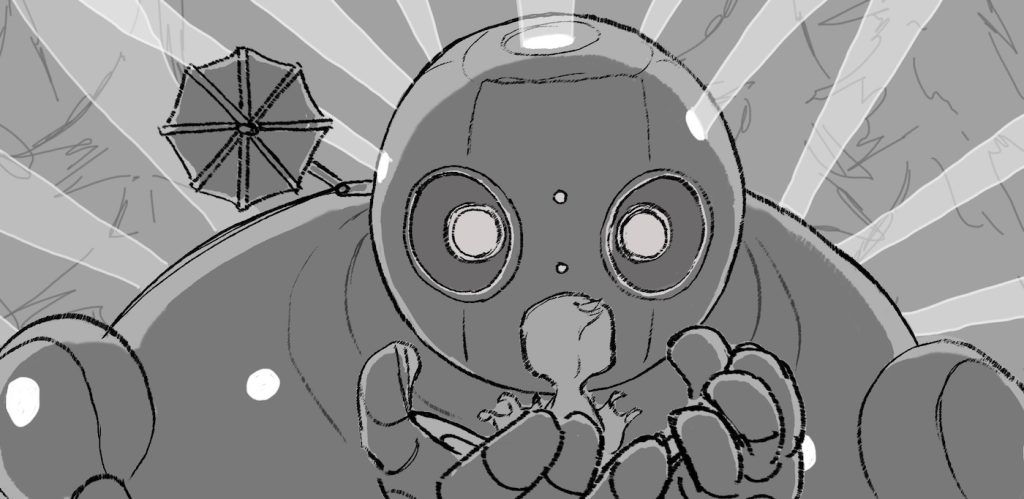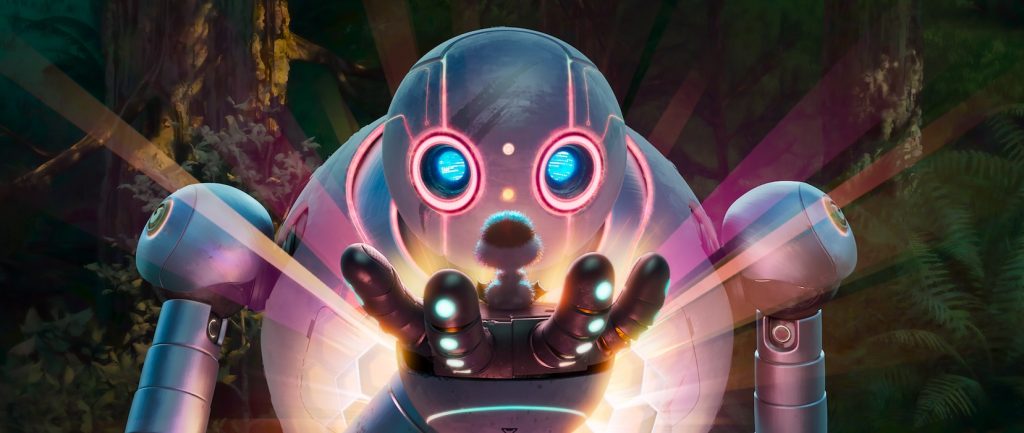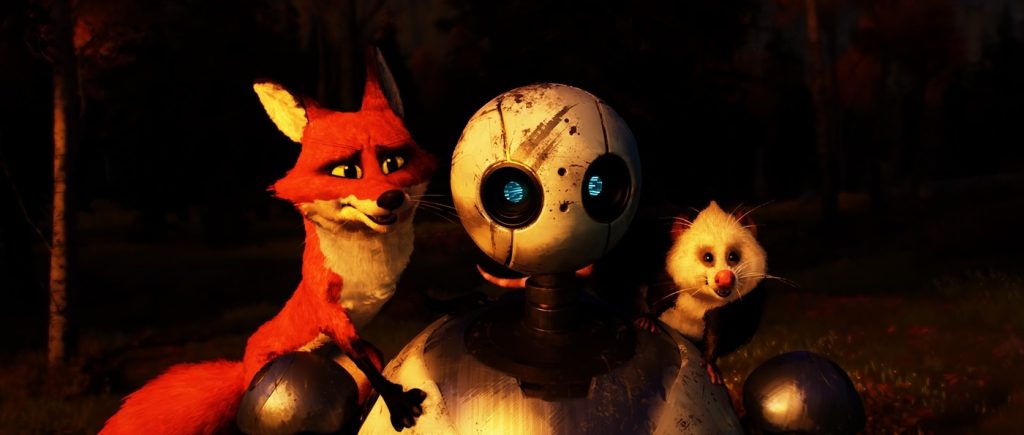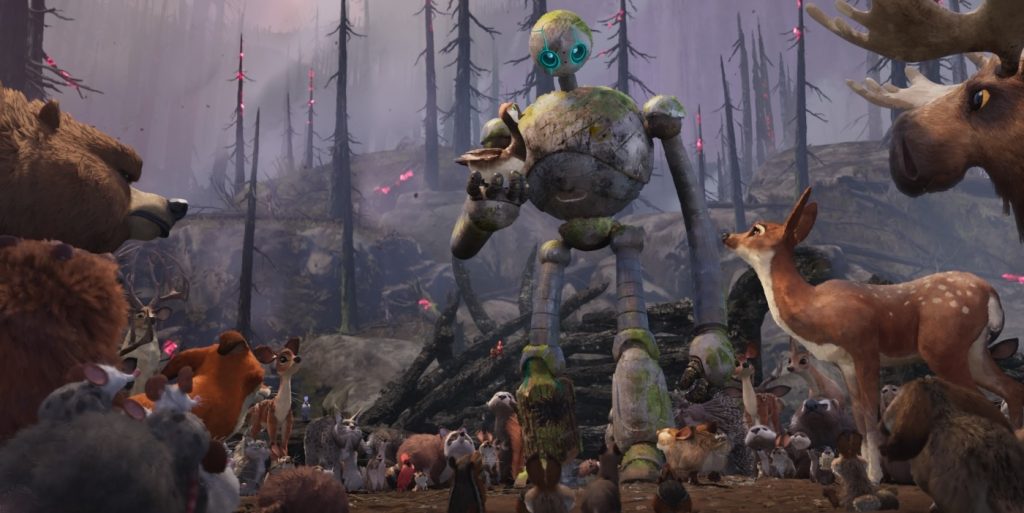“The Wild Robot” Head of Story Heidi Jo Gilbert on Motherhood’s Many Meanings
No one is more delighted that The Wild Robot has surpassed all expectations at the box office and with critics than director Chris Sanders. Receiving almost perfect reviews upon its world premiere at the Toronto International Film Festival, the film is headed towards record-breaking box office numbers for DreamWorks. Buzz has begun for The Wild Robot as a strong contender at this year’s Oscars. Only days ago, DreamWorks gave the green light for a sequel, with director Chris Sanders helming once again.
The story is about the sentient helper robot Roz (Lupita Nyong’o), who crash lands on an island and must adapt to her surroundings, building a relationship with local wildlife and becoming the adoptive mother of Brightbill (Kit Connor), the goose she has accidentally orphaned. She learns friendship and empathy by befriending island creatures, including self-serving fox Fink (Pedro Pascal), overwhelmed possum mom Pinktail (Catherine O’Hara), wise flock leader Longneck (Bill Nighy), and fearless falcon Thunderbolt (Ving Rhames).
There are a number of reasons for the success of The Wild Robot, including the combined star power of the voice actors and the incredibly collaborative partnership of the cast and crew. Of course, it all starts with a story and the cinematic interpretation of Peter Brown’s book series.
The Credits talked about the power and importance of story with DreamWorks’ head of story Heidi Jo Gilbert. Named by Variety as one of 2024’s 10 Animators to Watch, Gilbert headed the story team for the film and played an integral part in building the wonderful story lovers of The Wild Robot film see.
There are storyboards that you specifically did for the sequence when Brightbill and Roz first connect and imprints on her. What was your process on that sequence, and what were some challenges in hitting the right emotional note there?
When I first came on, I felt like Roz and Brightbill’s relationship was the thing that needed to come to the forefront of the story, and the moment where he hatches was very important. I remember having conversations with Chris and our editor, Mary Blee, about light. With Roz, could there be these lights that are emotional versus the ones that are robotic? That just kind of evolved, and then production took it and ran with it, and they created these hexagonal lights that come out of her that represent her emotional expansion.


Can you discuss one of the biggest challenges in character development and how you solved it in the film?
Well, we always love when there’s not a lot of dialogue, and especially the scene where she walks through the forest for the first time, we had versions of that with no dialogue. We ran into problems with that because it needed to serve as her character introduction, and when it was silent, we weren’t getting the personality or character from her that we needed for the rest of the movie. Figuring that out was a journey. There was also a lot of trial and error in unlocking or translating the language. It used to be spread out over the movie instead of taking place, as it does now, in one scene. It’s through a time-lapse that she does it quickly. Originally, it happened in chunks. On her screen, the language would start to translate, and there would be an actual bar with percentages. We placed that throughout different scenes in the movie but found the audience wasn’t absorbing it. If you go back and look at the movie now, you can still see scenes with very little dialogue before we solved that, We had to actually add some, like when she chases after Fink after he catches the egg, because before she couldn’t understand the language. It used to be that for the first 15 or 20 minutes, there was no dialogue, but we needed to make changes just based on the greater story needs or the bigger picture.
You have some great actors voicing characters for this film. Who among them had the most impact on the development of their character?
I feel like Lupita Nyong’o as Roz and Catherine O’Hara as Pinktail both had a big impact on those characters in the booth. We had a hard time finding Pinktail as a character in the movie. We had earlier versions where she wasn’t even a mom. She was just a wannabe actress. When we got Catherine, she really started to help us find the personality and who that character would be, and I think Chris came up with the idea of having her be a mom who was exhausted and overworked, but she really helped us find that as well.
And Lupita?
She was great because she would bring up all these points in her recording sessions that I feel like only she could do because she had to embody that character in her performance and be in Roz’s head. She would find things that were inconsistencies emotionally, in terms of how robotic she needed to be in the beginning and through the end. It was really fun just to see her refine that character, and it made it so much easier for us to track Roz’s robotic versus emotional arcs throughout the movie because she was so aware of it, too. So that just made our jobs a lot easier.
They are very much foils as well, in terms of how they express motherhood, with Roz being more gentle and Pinktail being more blunt and practical.
All true, but I don’t think we molded that intentionally; we just saw problems we needed to solve. First, Pinktail was an actress, then she was a mother, but she was a mom who had all this wisdom for Roz about caring for her children, but it wasn’t working. We actually did a brainstorming session with Joel Crawford and Januel Mercado, the directors of Puss in Boots: The Last Wish, and they helped us find her as edgier and careless about her kids, and when they pitched it, we knew it would work. It creates two sides of motherhood: the very exhausted and overwhelmed with Pinktail and the gentle and sensitive with Roz.

With multiple perspectives on motherhood, the whole story is just better.
Exactly. It can only happen when you have multiple mother characters. I heard Geena Davis, who is a great advocate for women in film, say that it’s hard to represent all of womanhood when you only have one female character. She brought up A League of Their Own, saying because they had a bunch of different female characters, they could show more facets of being a woman. Because we had multiple mother characters, we could show different sides and not put all the pressure on one character.

There’s a very positive aspect in this film that is threaded through the story, and the characters are in part in the service of that. Can you talk about that?
We have this dramatic argument going on in the characters about kindness as a survival skill. It’s one of the themes of the book we really wanted to represent, and to get that point across, we had to present the counter-argument to that, and we feel that’s most embodied through Fink, with his “dog eat dog” every creature for themselves attitude, doing whatever they have to do to survive. Pinktail represented the motherhood side of things. We wanted to make sure that in all the situations we put them in, we’d stay true to the characters we’d established with Fink, Thorn, and Paddler. Thorn also embodied the worldview of survival. He’s the one who attacks Roz at the beginning. He’s the Alpha predator on the island. In the scene with all the characters together, we land the emotional part first, with Roz saying how sometimes, to survive, we have to be more than we’re programmed to be. That is threaded through any and all story threads or business between characters, especially when they’re all together.
As much success as The Wild Robot is having, I love to believe it’s in part due to the collaborations of the cast and crew.
Absolutely. Chris Sanders is just so collaborative. It’s his vision, but if he hears a good idea, he’ll run with it, no matter where it comes from. He grew up through the story department, working on films like The Beauty and the Beast and Aladdin, and he sees the power of collaboration. If you get the right team together, with the right sensibilities, having someone who can challenge the story from a different point of view that supports the greater vision, it always makes the story better. He’s a great collaborator, not just with the story but in all aspects. Working that way has inspired me to prioritize and find that type of collaborative team. It’s very powerful to have that diversity of talent in the storyroom.
The Wild Robot is in theaters nationwide and available to own or rent as of October 15th.
For more on Universal Pictures, Peacock, and Focus Features projects, check out these stories:
“Conclave” Trailer Reveals Edward Berger’s Star-Studded Vatican-Set Thriller
See the Magic: “Wicked” Unveils Dazzling New Images From Oz and Behind-the-Scenes
Hear the Magic: “Wicked” Debuts Iconic Songs in New Teaser
Featured image: (from left) Roz (Lupita N’yongo), and Brightbill (Kit Connor) in DreamWorks Animation’s Wild Robot, directed by Chris Sanders.



